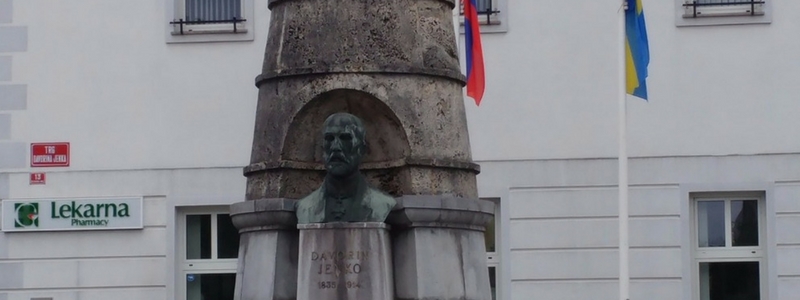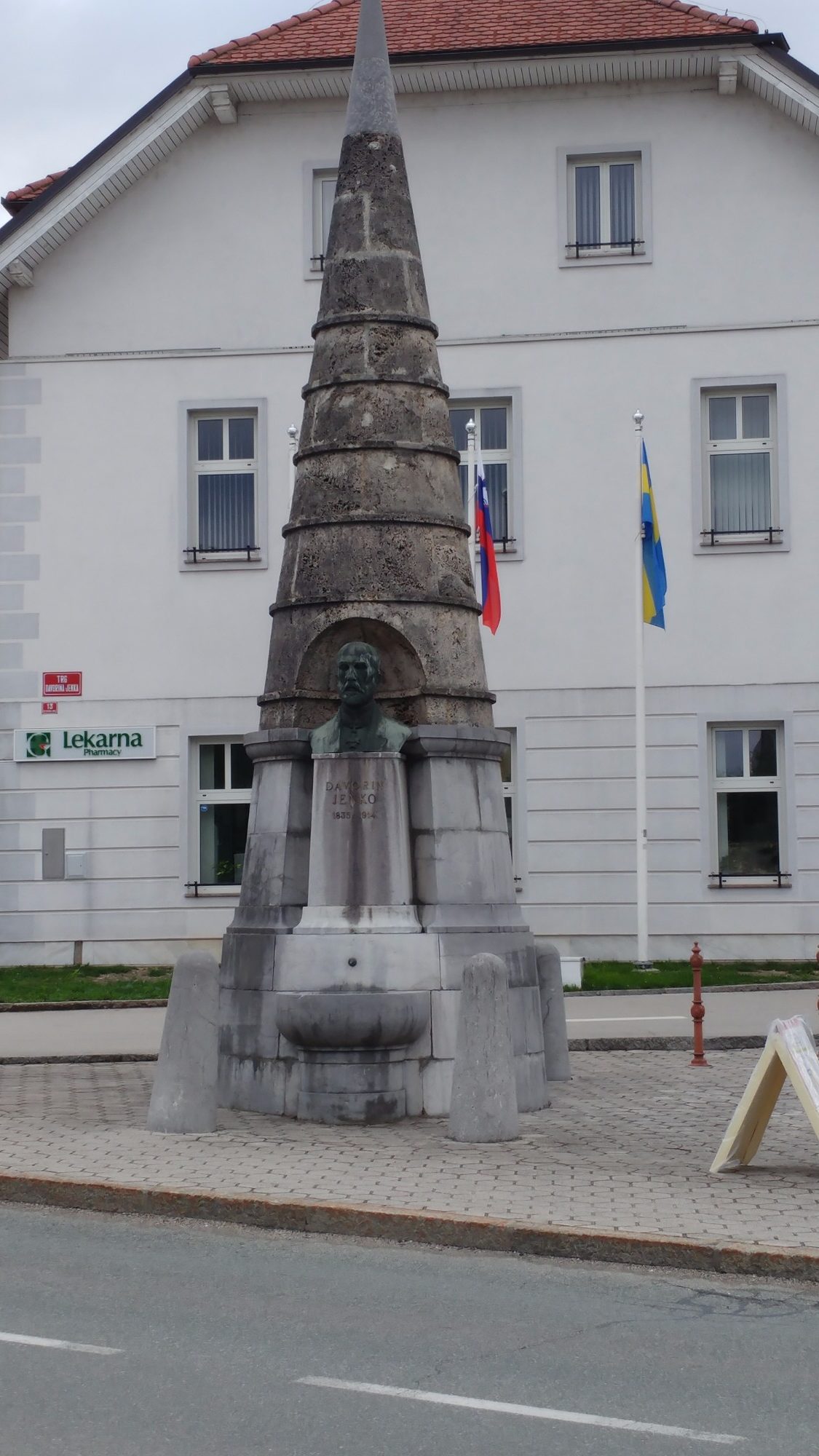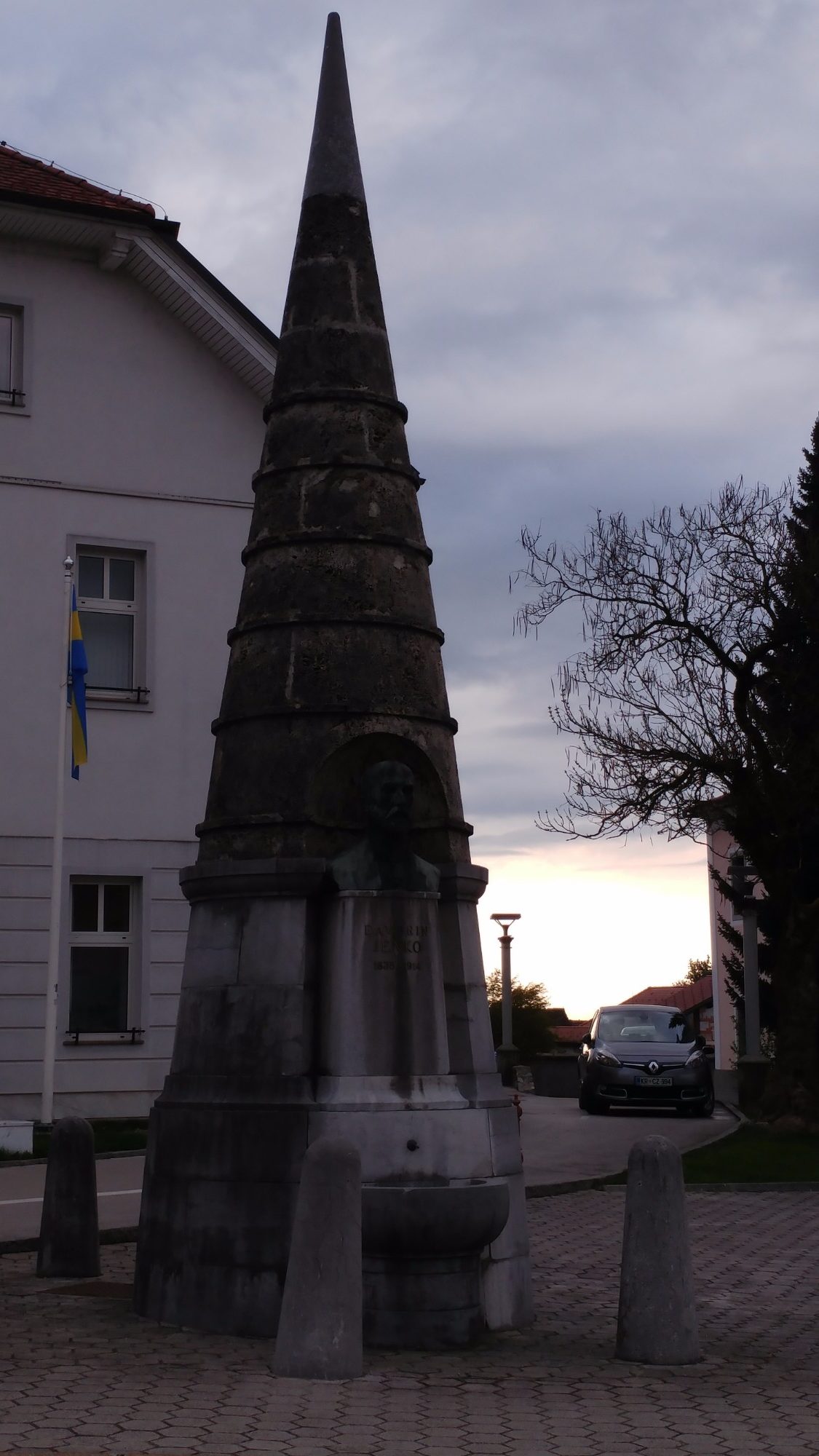Made by sculptor Lojze Dolinar, the bust of Davorin Jenko was erected at Cerklje in Gorenjska (Upper Carniola) in 1954. It was designed as a cone with a double fountain by architects Jože Plečnik and Anton Bitenc and built into one of the symmetrical semicircular niches.
Davorin Jenko
Composer Davorin Jenko (1835–1914) is recognised for his important output of songs, patriotic works extremely popular with Slovenian audiences that later became a crucial part of the national canon, and for both the Slovenian and Serbian national anthems. Passionately aspiring to stimulate a sense of Slavic unity inherent in the ideology of the Pan-Slavism movement, Jenko markedly influenced the cultural lives of Trieste and Vienna. During his stay in Vienna, he founded the Slovenian Choral Society, which promoted the endeavours of the Reading Societies in Slovenia. He later worked in Serbian cultural circles, and proved instrumental in fostering the development of Serbian choral singing.
Born in the Upper Carniolan village of Dvorje into a simple farming family, Jenko studied law in Vienna. Rather than studying, as he was not genuinely interested in the legal profession, he preferred to associate with the circle of Slovenian or Slavic students who met in Viennese inns and coffee houses to discuss relevant issues, topics concerning music and literature. At these gatherings, modelled after Czech patriotic events known as beséde, Jenko absorbed the ideas of Pan-Slavism in the company of the poet Simon Jenko and older fellow artists, Valentin Zarnik and Fran Erjavec.
He received his first musical education from the principal of the Philharmonic Society in Trieste, Francesco Sinico, and later on studied alone or with private tutors in Prague. He dedicated himself more seriously to scoring choral works during his stay in Vienna, and by 1861 had composed a wealth of choral pieces and lieder based on poems by Simon Jenko, France Prešeren, Fran Levstik, and Miroslav Vilhar, whose Lipa zelenela je (The Greening Lime Tree) became part of the Slovenian national canon, attaining the status of a national folk song, owing to Jenko’s compelling music. Depicting the change of seasons and evoking the anticipation of spring, a time of rebirth, the song became a symbol of Slovenian national revival and left an enduring mark on the cultural and social identity of Slovenians long after the composer’s death. An event from World War II testifies to the song’s pervading spirit of national loyalty. In 1941, under Italian occupation, when the APZ Tone Tomšič, a choir at the time comprising only male voices, performed Jenko’s Lipa to a full house at the Union Hall in Ljubljana, the audience joined in to emotionally display their ardent patriotic sentiments.
Another of Jenko’s songs that is of permanent value to the Slovenian nation is the popular Naprej, zastava Slave (Forward, Flag of Glory/or the Banner of Slava), which grew to become the first Slovenian national anthem (between 1860 and 1991) and continues to be the anthem of the Slovenian Armed Forces. Various choirs performed this song, along with numerous others, throughout Europe, and Jenko’s scores were reprinted a number of times.
Displaying a simple tonal musical texture and influences of folk timbre, Jenko’s music complies with the contemporary musical norms dictated by the cultural policy of Janez Bleiweis, who in 1862 wrote in Novice (Farmers’ and Craftsmen’s News), a conservative newspaper he edited, “A song must convey the national spirit and should be undemanding in terms of vocal technique, and melodious, so that it reaches the heart of the nation […], and is also sung by the people”.
Deriving inspiration from an aesthetic that was intended to promote a national cause, the artistic dimension common to Croatian, Serbian, Czech and Slovenian music, Jenko composed the melody for the Serbian national anthem, Bože pravde (God of Justice) and the popular Serbian and Montenegrin anthem Onamo, ‘namo! (There, Over There!). Jenko wrote these two works after 1862, when he worked as choirmaster of the Belgrade Choral Society and chapel master in the Serbian National Theatre, composing musical intermezzos to be performed between acts of a play.
Apart from vocal compositions, Jenko also wrote piano music and lieder.
Maia Juvanc


